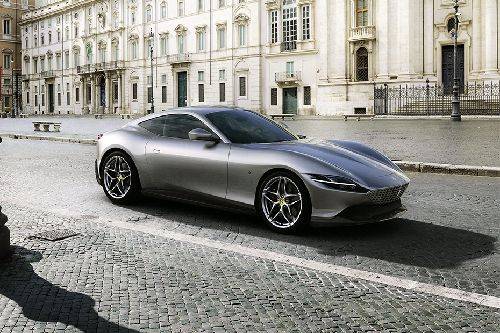One-off Ferrari SP51 is marque's next V12 spider in 50 years

MANILA: The Ferrari SP51, the newest model to join the Prancing Horse's One-Off line, was presented and now stands at the very top of Ferrari's customization scope and range. These cars are one-of-a-kind, completely customized creations made to a client's requirements.
KEY TAKEAWAYS
What is special about the Ferrari SP51?
The distinctive new car's most noticeable feature at first glance is its complete lack of a roof, which makes it a real roadster in every way and highlights both its sporty spirit and capacity to fascinate both visually and in terms of open-air driving exhilaration.How is the Ferrari SP51 a one-off?
One of Ferrari's top collectors and a longtime client with a presence in Taiwan, the SP51 Ferrari One-Off was created for them. It is Maranello's first front-engined V12 spider in 50 years.One of Ferrari's top collectors and a longtime client with a presence in Taiwan, the SP51 Ferrari One-Off was created for them. It is Maranello's first front-engined V12 spider in 50 years, and it succeeds as a roadster. At first glance, its edgy style captures the eye.
But it beautifully preserves the distinctive elegance of its model, the 812 GTS, while pushing the envelope by providing a completely new way to experience open-air driving.
A front-engined V12 spider created by the Flavio Manzoni-led Ferrari Styling Center, the SP51’s architecture, chassis, and engine are all derived from the 812 GTS platform.
The distinctive new car's most noticeable feature at first glance is its complete lack of a roof, which makes it a real roadster in every way and highlights both its sporty spirit and capacity to fascinate both visually and in terms of open-air driving exhilaration.
Naturally, the SP51's aerodynamics needed to be fine-tuned through a process comprising CFD calculations, wind tunnel testing, and dynamic testing to provide not just the utmost in interior comfort but also the same level of acoustic comfort and wind feel as the automobile that served as its inspiration.
The SP51's flawlessly muscular, undulating surfaces contribute to its powerful yet harmonious style. Due in large part to the significant usage of naked carbon fiber on both the outside and interior of the vehicle, its forms are simultaneously contemporary, sinuous, and sensual. The trim on the bonnet is particularly eye-catching since it frames the two air vents in a dynamic way.

The Ferrari SP51's new Rosso Passionale three-layer paintwork, which was created especially for the car and gives it an attractive yet imposing character that also emanates authority, is another of its most alluring qualities.
This impression is strengthened by the blue and white livery, which runs the length of the car and is also mentioned inside, and was inspired by a legendary 1955 Ferrari 410 S.
Unique headlights up front easily distinguish the Ferrari SP51 and give it a powerful personality of its own. The car-specific wheels, which have carbon-fiber wing shapes on each spoke and a clever tone-on-tone diamond-cut finish on the forward-facing area, are also remarkable.
The taillights are recessed below the spoiler and the rear of the automobile is dominated by an arching motif. Two flying buttresses that are immediately behind the cabin have been optically softened by two deep carbon fiber scoops. A transverse carbon-fiber wing with a profile that folds over the buttresses extends between these two components.
The resulting effect is vaguely reminiscent of a Targa-type car in which the flying bridge elegantly conceals the anti-roll hoop, a nod to the solution adopted on Ferrari’s early-1960s Sports Prototypes.
In the cabin, however, where dazzling new heights of craftsmanship and imagination have been attained, has to be the very apex of the rigorous honing process, in which the customer was involved at every step.

The decision to employ the same Rosso Passionale color that was specially produced for the outside as the primary color for the Alcantara trim and the brilliant notion of extending the longitudinal exterior paint into the cabin served as the centerpieces of its personalization.
The steering wheel stitching, the center tunnel, the fascia between the two seats on the firewall, and the white and blue stripes are all visible. This seamless transition between the outside and interior was made possible by the car's roadster architecture.
Also reflecting the SP51’s livery are the particular treatment of the door panels, bottom portion of the dashboard, and sides of the seats, which consists of a blue Kvadrat insert with white cross-stitching. The interior of the car features a lot of glossy carbon-fiber detailing, which works beautifully with the Nero Momo Opaco components.
A number of white embroidered embellishments, like the Prancing Horse and car logo, which can also be seen on the lower rim of the steering wheel, add to this look's stylish elegance and authority.
The Ferrari 812 GTS — which was made public in 2019 — heralded a victorious return for a model type that has played a crucial role in the history of the brand since its founding, exactly 50 years after the premiere of the last spider in the Ferrari line to feature a front-mounted V12.
Since the 365 GTS4, the front-mounted V12 architecture has not been utilized in a Ferrari series-production spider.

The 550 Barchetta Pininfarina in 2000, the Superamerica in 2005, the SA Aperta in 2010, and most recently the F60 America, of which only 10 were produced to commemorate Ferrari's 60th anniversary in the American market in 2014.
The 812 GTS is the spider version of the 812 Superfast, from which it borrows both its specifications and performance, most notably the engine, which is the most potent in its class thanks to its capacity to deliver a monstrous 788hp at 8,500rpm.
The 812 Superfast's remarkable acceleration can almost be matched by the combined 718Nm of torque, and the lofty 8,900 rpm rev limit ensures that spirited driving is unabated.
Similar to the Ferrari 812 Superfast, these performance levels were attained in part through engine design optimization and in part through new technologies like the 350 bar direct injection system and the variable geometry inlet tract control system that were developed for naturally aspirated F1 engines.
These systems made it possible to maximize power output while maintaining outstanding pick-up even at low revs by taking advantage of the displacement increase from 6.2 to 6.5 liters.
The dual-clutch transmission’s gear-shift strategies enhance the car’s sportiness. When the Manettino is in sportier settings, both up- and down-shift times have been significantly cut and the transition time has been optimized to enhance the driver experience. Combined with the shortened gear ratios, these modifications mean that occupants will instantly feel the car’s response to the throttle.

The geometry of the exhaust system was evolved to increase and balance the sound from the engine and tailpipes, with the aim of accentuating the car’s extremely sporty character with the roof down.
Exhaust-wise, prevalence was given to combustion order harmonics by modifying the geometry of the center extension pipes. All the pipes in the 6-in-1 exhaust manifold to the monolithic catalytic converter are of equal-length and this optimizes the sound by giving predominance to the first-order combustion harmonics.
The result is a full-bodied V12 sound in the cabin in all kinds of driving but which is particularly appreciable when the roof is open.

Photos from Ferrari
Also read: Meet the Purosangue, Ferrari's first four-door, four-seater SUV
Sell your car at the best price
 Verified and genuine buyers
Verified and genuine buyers
Ferrari Car Models
Trending & Fresh Updates
- Latest
- Popular
You might also be interested in
- News
- Featured Stories
Ferrari Featured Cars
- Popular
Ferrari Car Articles From Carmudi
- journal





















































